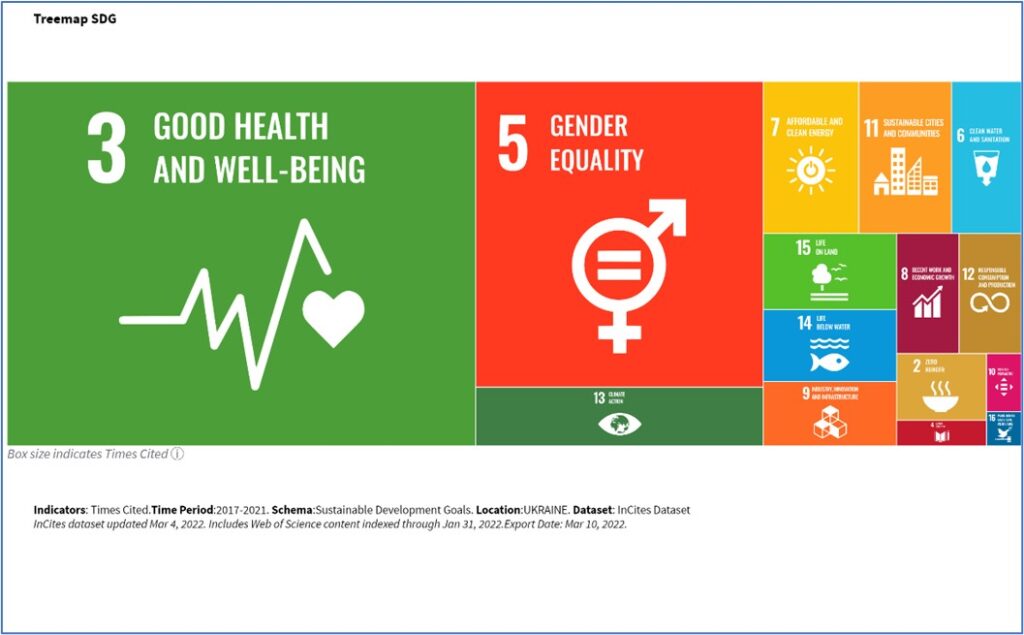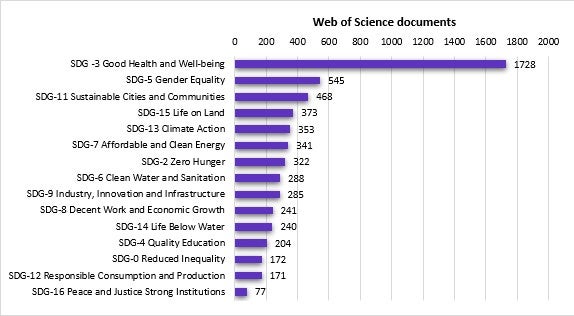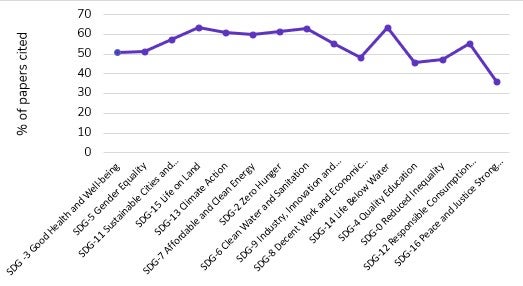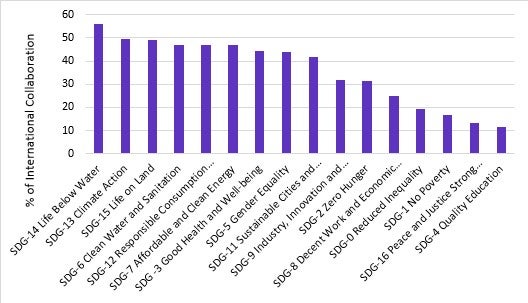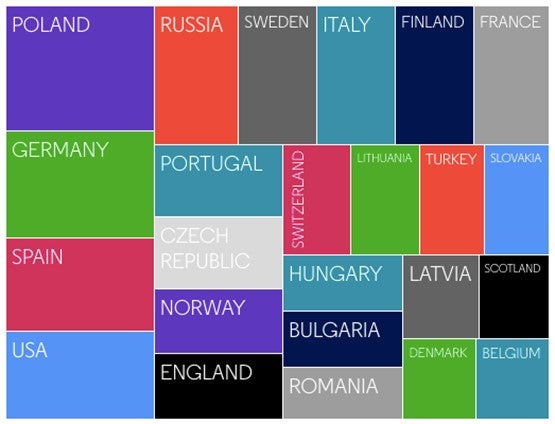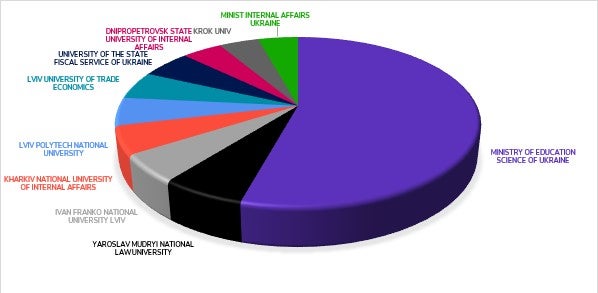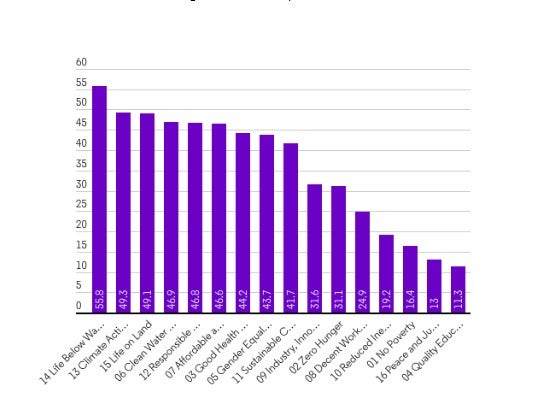At Clarivate™, we are committed to supporting the researcher community in Ukraine, including displaced researchers, during and beyond ongoing attacks on the country from Russia. Our research shows that Ukraine has contributed more than 5,000 scientific publications towards the UN Sustainable Development Goals since 2017, including on peace and justice initiatives (SDG-16). In this article, we analyze the content and impact of these papers, and discuss the global collaborative effort towards the Sustainable Development Goals—in Ukraine and worldwide.
The attacks on Ukraine by Russia have caused needless devastation and loss of life, leaving large communities without adequate food, water and power, and forcing more than four million people to flee into neighboring countries. This conflict will have lasting economic, social and policy implications for years to come, and it has and will continue to affect the advancement of research in Ukraine.
Clarivate continues to support calls for an immediate ceasefire and has taken several steps to support humanitarian aid in Ukraine, which we discuss in more detail later in this article.
In support of Ukrainian researchers, we also wanted to explore and uplift the region’s contributions towards the United Nations Sustainable Development Goals (SDGs) since 2017. Understanding Ukraine’s progress towards these goals is important not only because the Ukrainian research community currently needs our support, but also because global work towards the Sustainable Development Goals is collaborative. The progress and efforts of each nation secure a better outcome for all, as we work together to shape a better world.
With that in mind, we explore:
-
- What are the UN Sustainable Development Goals
- Highly Cited Papers™ mapped to the SDGs
- The impact of Ukrainian SDG research
- International collaboration towards sustainable development
- Ukraine’s contributions to SDG-16: Peace and Justice Strong Institutions
- Findings and recommendations
We cover these topics below and in our Ideas to Innovation podcast. Listen here for more.
- View podcast
What are the UN Sustainable Development Goals?
In September 2015, the 70th session of the UN General Assembly issued a universal agenda to achieve sustainable development globally. Known as Agenda 2030, it identified 17 Sustainable Development Goals and 169 supporting targets.
Ukraine joined the global effort to support and adapt the SDGs as a member of the UN. The SDGs identified by the UN were then adapted to the Ukrainian national context, setting specific goals for the economic, scientific and policy priorities of the nation. Each SDG was assigned partners within Ukraine, which include research institutions, government offices, nonprofits and more.
Tracking Ukraine’s progress towards the SDGs
In this article, we review the contribution of Ukrainian research to the SDGs since 2017, as seen through the lens of scientific papers in each area, their impact and collaboration with the international community.
For this analysis we’ve used InCites Benchmarking & Analytics™, the web-based research evaluation tool from Clarivate. InCites maps SDGs across institutions, countries and topics. In Figure 1, we show the distribution of Ukraine’s scientific output across all SDGs, with 1,728 papers focusing on SDG-3: Good Health and Well-Being and 545 papers focusing on SDG-5: Gender Equality published since 2017.
Figure 1: Ukraine publications across SDGs.

Source: Benchmarking & Analytics™
According to our data, Ukraine contributed a total of 5,863 scientific publications towards SDGs since 2017 (see figure 2). These results are in line with other sources of data including the Good Country Index which uses data from United Nations, the World Bank and other international institutions to calculate a country’s contributions to the “common good of humanity.” On this list, Ukraine was 13th in the Science and Technology category among 124 other countries in 2014, and 14th among 163 countries in 2020.
Figure 2: Number of Ukraine publications across SDGs. Source: Web of Science™

Source: Web of Science™
Highly cited papers mapped to the SDGs
The highest cited paper identified from Ukrainian researchers in support of SDG-3: Good Health and Well-being and SDG-5: Gender Equality, is Global, regional, and national incidence, prevalence, and years lived with disability for 354 diseases and injuries for 195 countries and territories, 1990–2017: a systematic analysis for the Global Burden of Disease Study 2017, which was published in The Lancet in 20182 with over 3,000 citations.
Figure 3: Highest cited paper SDG-3: Good Health and Wellbeing and SDG-5: Gender Equality. Source: Web of Science

Source: Web of Science™
The impact of Ukrainian SDG research
The scientific impact of Ukrainian research across SDGs is seen through the percentage of papers cited across the various SDGs. At least 60% of all papers published from Ukrainian researchers in SDG-15: Life on Land; SDG-14: Life Below Water; SDG-6: Clean Water and Sanitation; SDG-2: Zero Hunger and SDG-13: Climate Action have been cited. More than 50% of papers in SDG-7: Affordable and Clean Energy; SDG-11: Sustainable Cities and Communities; SDG-12: Responsible Consumption and Production; SDG-9: Industry, Innovation and Infrastructure; SDG-5 Gender Equality and SDG-3: Good Health and Well-being have been cited since 2017 (see Figure 4).
Figure 4: Percentage of papers cited across SDGs. Source: Web of Science

Source: Web of Science™
International collaboration towards sustainable development
- Ukrainian researchers collaborate with the international community across SDGs. Figure 5 demonstrates the percentage of international collaboration in each of the SDGs, showing that:
- For SDG-14: Life Below Water, 55.8% of papers are a result of international collaboration.
- For SDG-13: Climate action and SDG-15: Life on Land, slightly more than 49% of papers stem from international collaboration.
Using Web of Science™ analytics tools, we mapped the primary countries that Ukraine collaborated with within these SDGs. Figures 6-8 show that Poland, Germany and the United States are among Ukraine’s most frequent collaborators on scientific papers that correspond to the above SDGs.
Figure 5: Percentage of international collaborations per SDG. Source: Web of Science

Source: Web of Science™
Ukrainian researchers collaborate on papers mapping to SDG-14: Life Below Water across Europe and in the United States, particularly with Poland, Germany and Spain (see Figure 6).
Figure 6: International collaboration between Ukraine and other countries/ regions on SDG-14: Life Below Water. Source: Web of Science

Source: Web of Science™
On SDG-13: Climate Action, Ukraine collaborates primarily with Germany and Poland, followed by the United States, Austria and Russia. Our data shows that Ukraine also collaborated with Japan and Australia in this area. Another goal that sees a high percentage of international collaboration between Ukraine and other countries is SDG-15: Life on Land. Here we also see high collaboration rates between Ukraine and Germany, Poland and the United States, as well as with other countries in Europe and Asia.
Ukraine’s contributions to SDG-16: Peace and Justice Strong Institutions
Finally, we looked at Ukraine’s contribution to SDG-16: Peace and Justice Strong Institutions, where we identified 77 publications that mapped to this SDG. The top institutions publishing papers that map to SDG-16 are presented in figure 8, led by the Ministry of Education and Science of Ukraine, with 51 scientific papers since 2017.
Figure 9: Ukrainian institutions publishing in SDG-16: Peace and Justice Strong Institutions. Source: Web of Science

Source: Web of Science™
Findings
- Ukraine actively contributes to the scientific effort towards the Sustainable Development Goals with 5,863 papers published since 2017. Ukraine shows strong contributions especially in SDG-3: Good Health and Wellbeing and SDG-5: Gender Equality.
- Ukraine’s scientific output is also highly cited. At least 60% of all papers published in SDG-15: Life on Land; SDG-14: Life Below Water; SDG-6: Clean Water and Sanitation; SDG-2: Zero Hunger and SDG-13: Climate Action have been cited, while over 50% of papers in SDG-7: Affordable and Clean Energy; SDG-11: Sustainable Cities and Communities; SDG-12: Responsible Consumption and Production; SDG-9: Industry, Innovation and Infrastructure; SDG-5: Gender Equality and SDG-3: Good Health and Well-being have been cited since 2017.
- Ukrainian research is highly collaborative. While all papers mapped to the SDGs demonstrate international collaborations, over 50% of papers mapped to SDG-14: Life Below Water are the result of international collaboration. The countries Ukraine collaborates with the most are Poland, Germany, United States, Italy, Spain and Russia. Figure 10 shows the percentage of international collaborations between Ukraine and the global scientific community in each of the SDG areas. As can be seen over 55% of all Ukraine research on SDG-14 is a result of international collaborations. More than 40% of all research papers on SDGs 13, 15, 6, 12, 7, 3, 5 and 11 are the product of international collaborations. These collaborations address several different subject areas, but one focal point for many of these countries may be related to marine pollution in the black sea and clean up initiatives.
- SDG-16: Peace and Justice Strong Institutions doesn’t yet include very many publications, but is an important goal—especially now. Our data shows that the Ministry of Education and Science of Ukraine are leading local authorship in this area.
Figure 9: Percentage of international collaborations between Ukraine and the global scientific community by SDG

Source: InCitesBenchmarking & Analytics
Recommendations
The conflict in Ukraine could have devastating effects on its research community for many years to come. This will also affect the global scientific community given the Ukraine’s high collaboration rate across several SDGs. We hope that the insights we have shared here help to provide a greater understanding of the rich and varied contributions that Ukrainian researchers have made towards the SDGs as well as the strong potential from the region ahead.
In light of continued aggressions upon Ukraine from Russia, we at Clarivate have looked for ways in which we can support the Ukrainian research community. We have recently launched a Resource Ccenter that provides a package of software tools, information and insights for displaced researchers in Ukraine. You can visit our resource center here or view our statement about ceasing all commercial activities in Russia.
There are also several other community initiatives that support displaced researchers, including the team behind #ScienceForUkraine. This is a community group of volunteer scholars and students dedicated to highlighting the funding opportunities and student and faculty positions for Ukrainian researchers in universities worldwide. The European Commission has also recently launched its European Research Area for Ukraine, an initiative specifically dedicated to support researchers.
This post is the first of our new series highlighting the contribution from Ukraine to the global research effort. Coming soon, we look at the growth and diversity of subject areas in Ukraine. If you would like to read more about Sustainable Development Goals, view here.
About the author
Gali Halevi is Director at the Institute for Scientific Information. Previously she was Associate Dean of Libraries & Information Sciences at the Icahn School of Medicine at Mount Sinai and the Mount Sinai Health System. She has a background in bibliometrics and has worked in academic publishing and as an information specialist for pharmaceutical and financial companies.
ORCiD 0000-0003-1967-4147 ; Web of Science ResearchID AAD-2257-2021



